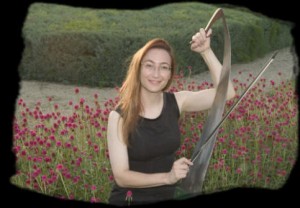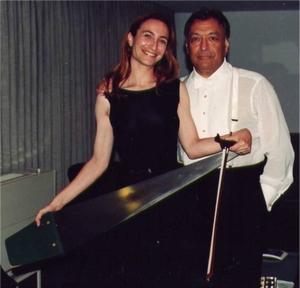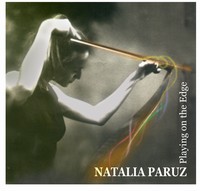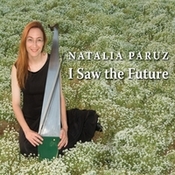Saw playing isn’t the most common form of music one is used to. It takes skill and hard work to master. It is an instrument that is both auditory and visually beautiful. Natalia Paruz has carved herself a successful career out of mastering this unique instrument. She has been nicknamed the “Saw Lady” and rightfully so. She has played in huge venues such as Madison Square Garden and supplied her talent to films such as “Another Earth”.
I interview the “Saw Lady” about her career, discovery of saw playing, her successes and her future goals.

1) What made you interested in performing music on a carpenter’s saw?
I was a professional dancer, until I was hit by a car. For a long time I couldn’t find anything that interested me besides dance (which I couldn’t do any more). I chanced to see a performance with a musical saw player in it, and for the first time since the accident I felt excited about something which wasn’t dance. Saw playing is very visual – the entire instrument moves and creates wave-like shapes in the air – it’s like dance… I was also attracted to the angelic, very pure sound which can be very spiritual.
2) You’ve performed with the Israel Philharmonic Orchestra, Westchester Philharmonic Orchestra, the Royal Air Moroccan Symphony Orchestra, the Manhattan Chamber Orchestra, the Amor Artis Orchestra, the Riverside Orchestra and at Lincoln Center’s Avery Fisher Hall. You’ve also performed at Carnegie Hall and Madison Square Garden. Any other accomplishments you hope to achieve?
I wouldn’t mind playing in the White House for a president of the USA… :) Seriously, I love playing with orchestras and I hope to do more of that, as well as play with more string quartets – there is wonderful contemporary repertoire composed for musical saw and string quartet by Scott Munson . What I have my eyes set on now is playing with a choir. I have never done that as yet. I wrote a short children’s story and I am in talks with a composer who specializes in writing for choirs about composing it.

3) You’ve provided your musical services to films such as “Dummy”, “Another Earth” and “I Sell the Dead”. What were these experiences like?
‘Dummy’ was different from all the others, because I am actually seen on screen in that one. They made me wear an awful pink dress for it :) But actor Adrian Brody was really nice and fun to talk with. For the other movies I worked mostly with the composer. It was fun to see how the music fit in with the on-screen action and how the music makes the scene come alive. Music, though very subtly and sometimes unnoticably, really does inject a lot of emotion into scenes and sort-of “tells the audience what to feel”. I think it is very cool.
‘Another Earth’ was different for me, because besides recording the music I also got to coach actor William Mapother to act as if playing a saw. That was fun because it was different from what I usually do, which is teach people how to actually play. I worked with him privately, and then I also participated in the actual filming.
It was very interesting for me to see the finished scene in the movie, because I know exactly how each shot was established. For example – when William was “playing” on stage, Britt Marling wasn’t even there. He wasn’t looking at her but at me, miming to him whether to bend the saw up or down. Then when Britt was sitting in the audience, William wasn’t there any more. Instead, they had me play the saw on stage, so Britt could emote to the sound. There is one instant where the shot is of only the saw, from behind. That shot was actually of me holding the saw. I am very impressed by how director Mike Cahill edited all this together. I think he did an amazing job!
You can see this scene here.
4) Your goal is to keep this rare art form alive and help it progress. Any specific steps you’re taking in doing this?
Establishing the NYC Musical Saw Festival 10 years ago was a huge step towards this goal. Through the festival musical saw players from around the world can meet, observe and learn from one another. Most saw players are isolated from other saw players. For many, the festival is the only place they get to see other saw players perform live. The festival also has workshops geared both at beginner as well as advanced sawists.
Besides teaching people to play the saw I have also invented a playing technique which enables one to play faster, more precise and louder.
I also introduce the instrument to composers and commission works from them. I believe that the reason why saw playing declined in the past, after it enjoyed a measure of popularity at the end of the 19th century/beginning of the 20th century, is because it never had a repertoire of its own. Sawists mostly played arrangements of music written for other instruments. I believe that if this art form is to survive, it needs a repertoir of its own, same as any other “regular” musical instrument.
5) Who were your inspirations growing up?
I was very lucky to have many strong minded women around me when I was growing up: my grandmother who was a singer (whom I never met but stories about her lived in our home), my mother – a concert pianist, my Ballet teacher, then later choreographer Martha Graham (I was lucky to study with her a year or so before she passed away) and theremin virtuoso Clara Rockmore.
Other influences were my mothers friends, mostly musicians but also other types of artists. Pianist Glenn Gould was my baby-sitter one day – I learned about ‘daring to go against the accepted’ from him. And composer Olivier Messiaen taught me to listen for colors in music.
6) What is your favorite piece of music you’ve conducted?
Whatever piece I happen to be currently working on.

7) You started busking in 1993. What are your fondest memories of this?
There are so many it could fill a book… I like to tell the tale of one day when I was playing at Times Square. There were a few people standing around me listening, including a blind man on my right. As I played, his face lit up. It was obvious he was enjoying what he heard. On my left there was a woman, who had nothing to do with the blind man. They were two strangers who happened to walk by me at the same time. She, too, noticed the joy on his face. She came over to me, purchased one of my CDs, went over to the blind man, put the CD in his hand and said: “This is the music you are listening to now. This is for you”. She spent her own money to buy a present for a stranger! To have my music be the impetus for such an extraordinary act of kindness – that was a priceless experience for me.
8) Are there any other musical instruments you know how to play?
While the musical saw is my main instrument, I also play English handbells, both as a soloist as well as part of a group of ringers. These bells sound angelic and controlled. I also play a set of 65 pitched cowbells – these have a happy sound and thee isn’t much volume control possible.
My newest instrument is actually my oldest… It is new to me but it was made before 1836: the glass harp. I am just now starting to learn to play it. It has a spheric type sound, almost the sonic equivalent of fairy dust :)

9) What do you have planned for the future?
Everyone tells me I should write a book about my life as a saw playing busker, so I guess I should clear away some time, and set to it.
10) Any words of inspiration for aspiring musicians?
If you want to succeed then application, diligence and cheerful persistence!
You can download the Saw Lady’s albums at www.SawLady.com and stay updated and contact her via her Facebook, and Twitter, @SawLady.
I’d like to thank Natalia “Saw Lady” Paruz for taking time out of her schedule to conduct this interview!
